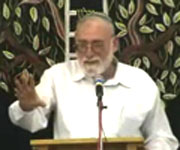Beit Midrash
- Sections
- Chemdat Yamim
- Parashat Hashavua
- Shabbat and Holidays
- Sukkot
- The Spirit of the Holiday
The holiday of Sukkot, which has a central mitzva of joy, comes after the Yamim Noraim (Rosh Hashana and Yom Kippur), which serve as an introduction to it. Sukkot is the Festival of Harvest, which makes it a holiday of joy regarding the natural world. However, the Torah wanted it to be a fulfillment of "… and you shall rejoice before Hashem" (Vayikra 23:40). It is not enough to have simple simcha – it should be elevated. And that is impossible without having the special Days of Awe precede it.
On the pasuk from "L’David" (Tehillim 27:1), "Hashem is my light," Chazal teach us that light is refers to Rosh Hashana (Vayikra Rabba 21). The introspection and purification that we undergo reveal for us the path we should be taking. The tzaddik is saved from evil people only by merit of the fact that "the path of the evil is in darkness" (Mishlei 4:19). The evil person is incapable of calculating his path in advance, for he does not know in what way he will stumble, as he is led by a host of external factors that influence him. Sometimes the rasha is not even aware of what is going on. As the Tanya (11) says, reshaim are full of regrets.
The tzaddik has light in his path. He knows what is a spiritual stumbling block and what is forbidden. However he still needs to fight to save himself. Chazal (Sukka 52b) attach to this fight the pasuk (Tehillim 37:32), "the evil one looks toward the righteous and seeks to kill him," from which they conclude that if Hashem would not help the tzaddik, he would be unable to withstand the evil inclination. Since the person is still struggling, his tendency to serve Hashem through fear is stronger than his feeling of spiritual joy.
After the Yamim Noraim, our task is to go to a higher plane and reach the level of those with "straight hearts" (see Tehillim 97:11) and of "my heart is a corpse in my midst" (Tehillim 109:22). These indicate that there is no longer a raging battle. Then all the person’s body, being, and actions will be in service of Hashem. If during Rosh Hashana/Yom Kippur, we elevated ourselves above matters of the physical world, cordoned off from the world, in shul involved in Torah and prayer, then during Sukkot we go back to normal life, with normal concerns – but also with great simcha. The simple, natural joy can be raised to the level of service of Hashem
Therefore, in years like this, when there is nothing to be happy about, the Holiday of Joy still remains. We will just commemorate it as an opportunity to rectify the sin of "you cried without cause…" (Ta’anit 29a, on the first Tisha B’av, when Moshe’s spies came back with a bad report about the Land). We will have to be happy with nothing to be happy about and act with joy at the time that it is called for. May Hashem help us merit seeing the captives of Hashem return with eternal joy on their heads (based on Yeshayahu 51:11).

Why Do Children Start With Vayikra?
Rabbi Shaul Yisraeli zt"l | 5771

Parashat Hashavua: Can One Give a Loan to Hashem? – part II
Rabbi Yossef Carmel | Elul 5785

Parashat Hashavua: From Paroh to Hamas and Iran – In Those Days at this Time
Rabbi Yossef Carmel | Kislev 5786






















